Kali Linux - How to Add or Remove Users
This guide accomplishes:
The main reason I wanted to try this to demonstrate the followings:
- Add a user with all user directories already in place (thereby avoiding “Could not update .ICEauthority var/lib/gdm3/.ICEauthority” or any error containing .ICEauthority or permission in general.
- Add user to sudo group to allow him to use root commands. You can also add user to ‘lpadmin’ group to allow printing for Canonor HP and such.
- Change default shell from chsh to bash. Or any shell like Bourne Shell (sh), Bourne-Again Shell (bash), C Shell (csh) or Korn shell (ksh) etc.
- Login as that user and demonstrate there were no errors.
- Be able to use sudo and show groups affinity.
- Delete that user safely.
Benefits of Standard User in Kali:
Few benefits you have as non-root or standard user in Kali
- Install and run Google Chrome
- Install and run Gnome User and Groups manager (Install gnome-system-tools)
- Use Kali as Primary Operating System without worrying about breaking it all the time.
Now let’s move onto actual guide.
Add user in Kali Linux:
- First of all let’s confirm which version of Linux and Kernel I’m running.In command prompt type in
uname –a
lsb_release –a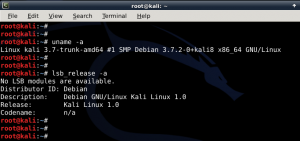
- Now let’s add user. Open terminal and type following to create new user (replace user1 with your desired user name)
useradd -m user1

(Note: -m means create home directory which is usually /home/username)
- Add user to sudo group (to allow user to install software, allow printing, use privileged mode etc.)
usermod -a -G sudo user1

(Note: -a means append or add and –G mean to specified group/groups)
- Change default shell of previously created user to bash
chsh -s /bin/bash user1
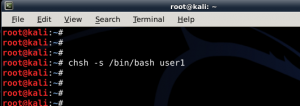
(Note: chsh mean change login shell, -s is the name of the specified shell you want for the user, in this case /bin/bash)
Nice, all worked out as expected.
Let’s logout and login back as our new Standard Non-root user (user1)
Login as new user
- Once logged in, let’s confirm from command line who I really am! In terminal type in the following
whoami

Take note of user1@kali prompt. That also confirms who you are. - And let’s check my group affinity, type in the following in terminal:
groups
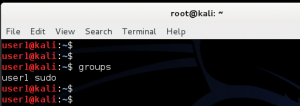
Looks good to me so far.
I am part of user1 group (my primary) and sudo group. That means I can run privileged commands or just become root myself if required. - Become root!
sudo su –
and type in user1’s password to become root.
See the prompt becomes root@kali instead of user1@kali. That means you’re now root and get to run anything Kali got to offer. - Lets confirm that using whoami command
whoami
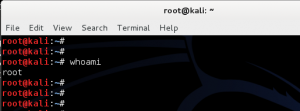
So far so good. Now how do you delete a user?
Delete user in Kali Linux:
- Log in as root user again. Open terminal and type:
userdel –r user1
(Note: -r means delete all files and home directory for user1)
You can replace user1 with your desired user name.
I have an error “user1 is currently used by process 5866”.
So process ID 5866 is being used by user1. (I know that it’s the gnome-keyring process running in background when I used sudo su – command earlier. (Gnome-Keyring error is quite common in Debian when you install multiple Windows or Desktop Managers.
Let do that. - Type in the following in terminal to kill the process used by user1.
kill -9 5866
This kills the process immediately.
(Note: don’t kill root or system processes unless you know what you’re doing) - Now let’s try to delete the user again.
userdel –r user1

We have a message. “userdel: user1 mail spool (/var/mail/user1) not found”.
(Note: -r means delete all files and home directory for user1)
Are we going to worry about it? Not really, we never created a mailbox for user1. - Just to confirm everything for user1 was deleted list files in home directory
ls /home

Nothing.. that’s good news, all files and folders were deleted for user1. - Want to double-check?
su user1

Perfect user1 was deleted successfully.
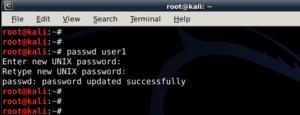
No comments:
Post a Comment